Candling Eggs is an easy process that gives you assurance that your eggs are fertile and developing correctly after a short period of time in the incubator. It allows you to remove infertile eggs and soon you will start to be able to identify ‘bad eggs’ and remove these as well. The candling photos on this page should help you to identify these.
Although it has never happened to me, bad eggs can sometimes explode or ooze in the incubator causing bacteria to contaminate the other good eggs, causing them, in turn to go bad.
I usually candle my eggs after a week of incubation. It can of course be done before this but the first week of incubation is the most critical in terms of getting the correct development of the embryo so leaving the eggs alone during this time is good practice. After a week, we are a third of the way through incubation and it is far easier to identify fertile eggs, even if eggs have a dark shell as is the case with Marans.
How to candle eggs
You will need a bright light and a way of shining this through the egg. Candlers can be bought online from poultry shops, or you can make one using a bright light and a cardboard box with a hole cut out for the egg to sit on. Try to get the best seal around the hole and candle in a dark room to see the best results.
Candling Dark Eggs
If the shells are dark or have pigments / marks on them, it can be difficult seeing the embryo. I rock the egg from side to side very gently so the contents move. This must be gentle, or you risk damaging the Chalazae that hold the yolk / developing embryo.
“The Chalazae is the structure that suspends the yolk within the egg. It can be damaged by shocks and vibration”
Remember not to candle for too long if it is heating the egg. I spend around 8 seconds per egg before trying the next one.
What to look for after a week
After 7 days, you should be able to see development of the embryo, including spider like veins and even (if you are lucky) a little movement. The embryo often sits on one side of the egg so be sure to rotate the egg around slowly to get the best view. Occasionally, you may see a tiny heart beating if it is close to the edge of the shell.
Look for fertile and non fertile eggs. Clears as they are called are easy to remove after 7 days. If you have a number of eggs in the incubator, it soon becomes clear which eggs have developed correctly.
By day 7, you should clearly see the embryo. Don’t forget to turn the lights out in the room when you do this so you get a clearer picture!
What to look for after two weeks
After 14 days, the embryo is well developed and turning into a chick. Two thirds of the egg is now covered and it is hard to see any detail.
Look for embryos that have developed so far but died. This can be for a number of reasons, including incubation technique, damage to the chalazae (which can happen when eggs are dropped / damaged in the postal system for example) or become infected with bacteria. A red ring is sometimes seen inside the egg which is the bacterial infection.
The photo to the right shows how much of the egg is now filled with the embryo / soon to be chick. It is more common to see movement inside the shell.
Bad Eggs
If an egg appears bad, it can be removed to prevent it from exploding and contaminating other eggs. Bad eggs can look different every time but if you compare them to the bulk of the other good eggs in the incubator, it won’t be long before you can recognise a bad egg from the rest. The bad egg shown to the right was found at day 14, two weeks into incubation. Clearly comparing this to our last photo, there is a problem.
Bad eggs don’t change – so if you are unsure, mark it and have another look a few days later to see if it still looks the same.
The second photo shows to the right shows the contents of this bad egg after it was opened on a plate. I wouldn’t normally do this because it can be smelly but was worth while to show what the contents looked like, clearly not a nearly developed chick!
There are a few more photos on poultrykeeper’s candling chicken eggs page here.

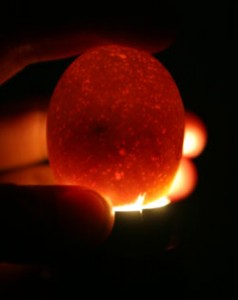
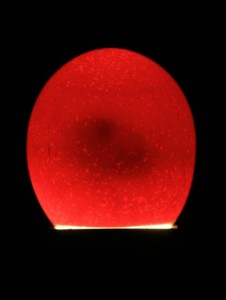
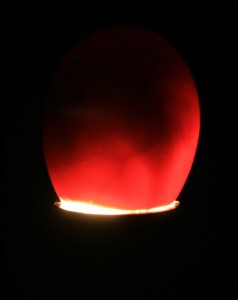
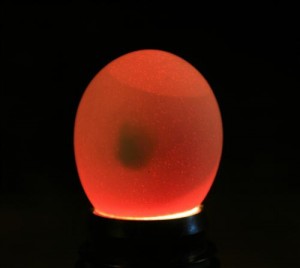
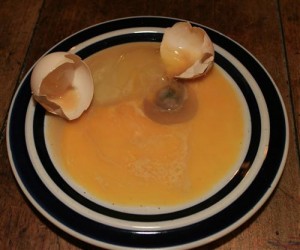



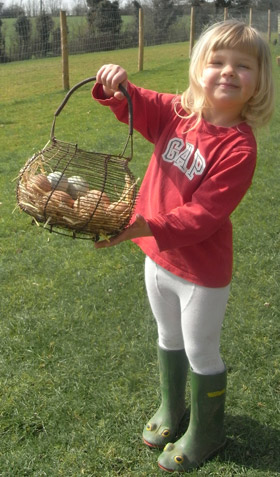

I’m having a hard time with candling. It’s been 9 days and I can see a big dark cloudy area, but i don’t see anything that looks like veins. Thanks
It’s easiest with the lights off. Try rotating the egg slightly too as sometimes the embryo is closer to one side. At this stage, a dark patch in the middle is just the yolk / an infertile egg.
im lost on this pick a boo stuff… my eggs are now 7 days, n i see nothing but black splotches… help… i cant tell what is good n what is bad… i dont want an egg to blow up, this would blow up an incubater, smell up my house and not to mention the cost of replacing and cleaning… please let me know how to stop this and have healthy chicks… or at least a couple of healthy chicks… worried chicken mom..
Try turning the lights out when you do it. It is hard at first – you can wiggle the egg gentle to see the contents move back and forth slightly (GENTLY THOUGH!). This helps you see what are markings on the shell and what is inside.
I got eggs from three different hens. I am sure a couple of the eggs are not viable because I can notice the red ring on them. There are a couple that are heavy and look like your 2 week old eggs… don’t know if the embryos are alive. Other eggs look fine (veins and nice dark spots – they look like your 4-5 day old ones). What should I do? Should I let them all hatch at different times? Which ones should I keep if not? I’m a firt timer and have two kids on my back every time I approach the incubator :/
If they are different ages then you’ll have difficulty – The eggs that hatch first need high humidity for the last couple of days of incubation and when they hatch will put bacteria all over the place which usually means the other eggs won’t hatch afterwards…
Hi. I’m taking a go at this egg incubating and I am having a difficult time telling whether my eggs are still good. I just candled them, day 7, and I can see the eyes of the chicks. However, the blood vessels don’t “spider” the egg. Is this normal or should I discard the eggs? I had 11, now 9, and one that I threw away didn’t show a baby chick but when I cracked it open, there was one in it. Does this happen often? Additionally, one of the eggs seems to have large vessels and I cannot tell whether this is just large vessels or the beginning of a blood ring.
I have a still air incubator and as I’m sure you know, maintaining the temp has been difficult. It got really hot in it today (120) for a short time. Is it still possible to hatch healthy chicks? Thank you!
High temperatures are likely to kill an embryo. Candling does come with practise.
I have an egg that is a dark green and it is too dark to see through when I candle it. Is it rotten? It is only three days old and what does a healthy chicken egg look like while you candle it? My idea is just as long as it isn’t dark and light.
Try candling in the dark. Dark shells are harder to candle, some nearly impossible. Don’t candle until 7 or 8 days or you won’t be able to see anything as development is so small.